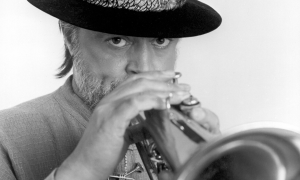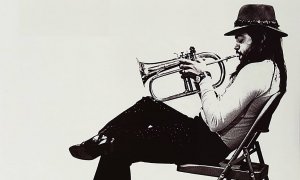Home » Jazz Articles » Catching Up With » Mark Shuman: Morphine's Music Still Resonates With me Today
Mark Shuman: Morphine's Music Still Resonates With me Today

Wrongfully tagged as an alternative band at the time, Morphine went on to surpass its 1990s contemporaries and it even transcended the label alternative. Even its late frontman bassist Mark Sandman had a different name for what the band was creating -"low rock." It was a guitar-less band at the time when guitar bands reigned supreme. Armed only with a two string slide bass, drums and bass, the band created timeless music that drew from a variety of styles—jazz, funk, rock, and blues. It was a unique and potent cocktail and people worldwide loved that. Shuman's documentary features footage from as far back as the Sandman's earliest bands and projects in Boston and then follows the band's story as it becomes one of the most popular concert attractions in the world up to the moment of Sandman's untimely death on stage in Italy due to a heart attack. Shuman uses a well-balanced mix of talking-head interviews and archival footage in order to tell the story of this much beloved band.
All About Jazz: Where did your love for Morphine's music begin?
Mark Shuman: I first heard the band when I owned a live music venue in Austin, Texas called the Electric Lounge . It was 1993 and I was booking the music at the club with my partner Jay Hughey. Ryko sent copies of their first two albums (Good and Cure For Pain) and posters for us to us to check out. Jay and I fell in love with their music and started playing it every night in the club and of course we booked them.
At this point, Morphine was on a small club tour and Cure for Pain was just starting to catch on. They would play one club with 20 people and a sold out club the next night. By the time they arrived for what was our club's first big roadshow, the club was sold out, oversold actually ! I was there for soundcheck and the minute I heard the first song, the sound of Dana Colley's sax with Mark Sandman's bass and vocals, rounded out with Billy Conway's drums, it was sonically unlike anything I had ever heard before. We became friends with the guys and hung out with them every time they came back to Austin to play. Their music still resonates with me today. It's funny, but before I did the documentary, several people told me I would never want to hear their music after editing the film. The exact opposite happened, I enjoy them as much today as I ever did.
AAJ: What was the impetus for you to pursue the idea of a Morphine documentary?
MS: I had been thinking about it for years after the tragedy the band suffered in the 1999, which led to the end of Morphine as a band. Years earlier, when hanging around with Dana Colley, I noticed he was writing in a thick cloth covered book. I asked what he was doing and he told me he kept a journal while on the road with Morphine. I was at SXSW music festival in Austin in 2009 and someone texted me a photo of Dana playing sax with an Electric Lounge t-shirt on. I asked them to tell him to stay there and we met up again for the first time since 2000. We hung out all weekend and caught up and during this time I asked him if he still had the journals and if anyone had considered doing a documentary about the band and their journey. He was in to it and that is how it started.
As far as why I did it, I felt that Morphine was being lost to history and their story need to be told. It was hard for me to believe that with the amazing career they had and their incredible timeless music, that they were not receiving more recognition.
AAJ: What was your primary aim in making of this film?
MS: I wanted to capture what it was like for the band to be on this wild ride to fame and for it all to stop in one day. From their perspective and those closet to them as well. I also wanted to stay true to the story without over directing it. So many music docs today try to be so much and lose the story with famous talking heads covering the music. I tried to leave room for the music to breath and stand on it's own without alot of commentary over it. I wanted to let them tell their story and let the audience gets a feel for what it was like to be along for the ride. I also wanted to show how great they were as a live band and to see the music performed in different live settings. I was very lucky to get the archive from the band and to be able to find so many performances. Mark Sandman had kept all of the tapes from their years on the road, so it gave me a lot to choose from. I hope the film is embraced by-current fans of Morphine and future fans who don't know anything about the band yet.
AAJ: How did you approach the band and the people close to the story for filming, and how did those people react?
MS: Well, I knew Dana and Billy (Morphine Drummer) and Phil Davidson (Morphine Soundman) so that certainly helped! They opened many doors with those closest to them. Still, I was very methodical about my approach. I certainly did not know the entire story, so as I would interview someone, I would go back and look for threads and think about it before I decided who to interview next. Everyone was willing, but of course it was tough for them to open up and talk about the painful side even after so many years
Because of the new camera technology, I was able to sit one on one with them and talk for 1.5 hours without stopping and it became very comfortable and conversational. Also people like Steve Berlin and Henry Rollins were amazing. I was told Henry had fifteen minute to interview, but one hour later we were still at it! At one point I was going to interview additional well known people who loved the band, but with the help of an editor friend of mine (Malcom Hearn), I decided to bypass that and stay focused on the nuclear Morphine family.
AAJ: What were some of your fondest memories from the shooting of the documentary?
MS: I enjoyed it all. I filmed in Italy, Boston, Los Angeles, Austin, New York and Boston. Of course it is a ton of work and at the end of the day filming a documentary a bit of a lonely job, but for me shooting was a very fluid experience. Meeting people and learning more from each interview was great. Also shooting in Rome and Palestrina, Italy was certainly memorable and impactful. My wife was with me and we had a great time seeing the Vapors of Moprhine perform on the tenth anniversary of the end of the band there. Shooting a documentary is the fun part, the intense work really comes after with editing and post-production and the selling of the film. Filming Dana reading his journal entries was a high point for me. It was the last thing we shot and I felt like the film was really coming together at that point.
AAJ: What's your most enduring memory of Mark Sandman?
MS: I think the fact that he was a very cool guy to be around. He had a presence of experience and a laid back nature. He was very careful and thought before he spoke, so I don't think some thought he was approachable, but he was and had a great sense of humor. When he played he OWNED the stage, moving back and forth across it as he strummed away on his two string slide bass in between his vocals.
AAJ: What were some of the challenges involved in the making of this project?
MS: There were many. Funding was tough as started the documentary after the economic troubles in the US. Initially, before we knew how bad things were going to be, it looked like I was going to be able get the money, but it fell through. As it turned out, I paid for it all and that is one of the reasons it took several years. I would work on it, stop, go make some more money working on commercials and come back to it. In the end this allowed me to make the movie that I wanted to make without answering to anyone except the audience. Also the editing process was definitely part of the toughest part. I had over 100 hours of footage and trying to cut it down to 90 minutes without losing the true story was a constant concern. Overall the tragic aspect of the story became hard to work on day in and out during editing. Both of my editors (Mike Mariconda and Leah Marino) also had a hard time with this, but I took this as a symbol of how invested they were in the story of the film. I learned during the process how important is to just keep moving forward and do something, anything, each day to keep the project moving.
AAJ: What do you hope audiences will take away from this film?
MS: I hope the fans will see and learn something new about Morphine and will have a greater understanding of who and what they were as a band. As for the audience which does not know of them (a majority percentage at each screening), obviously I am hoping to introduce Morphine to them. It is very important that that the younger generation learns about them and I edited the film with this in mind. I hope it stirs more interest in Morphine's music for them. Vapors of Morphine (Dana Colley, Jeremy Lyons, Jerome Deupree, Billy Conway) are still playing and building big a fan base in certain US cities and regions of the world and I hope it helps them with this.
AAJ: What's in the future for you and the film? Can we look forward to a DVD release?
MS: Well we are still on the festival circuit. Next is Indianapolis Indy Film Fest and Grossman Festival in Slovenia. London and maybe Italy after that. I am trying to decide whether to continue for another few months after November which will have been a year of festivals, it depends on several factors. I am going to a couple of documentary market festivals in the coming months to work on this, looking for the right distribution deal as I want Morphine's international audience to have a fair chance to see the film.
Tags
PREVIOUS / NEXT
Support All About Jazz
 All About Jazz has been a pillar of jazz since 1995, championing it as an art form and, more importantly, supporting the musicians who make it. Our enduring commitment has made "AAJ" one of the most culturally important websites of its kind, read by hundreds of thousands of fans, musicians and industry figures every month.
All About Jazz has been a pillar of jazz since 1995, championing it as an art form and, more importantly, supporting the musicians who make it. Our enduring commitment has made "AAJ" one of the most culturally important websites of its kind, read by hundreds of thousands of fans, musicians and industry figures every month.






















